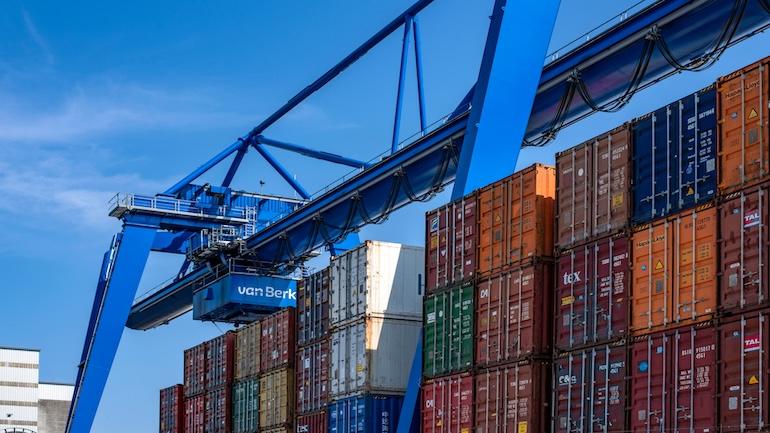
For those skeptics who claim the U.S. tech supply chain can’t be shifted to domestic production, NVIDIA has a response: We’re doing it.
The chip maker—responding to President Trump’s tariff strategy—has announced a number of initiatives to produce semiconductors within the continental U.S. that it claims will create “hundreds of thousands of jobs and drive trillions of dollars in economic security over the coming decades.”
NVIDIA has unveiled plans to build “more than a million square feet” of U.S.-based manufacturing space. The company has launched production of two supercomputer manufacturing plants in Texas, working with Wistron in Dallas and Foxconn in Houston. NVIDIA forecasts that within 12-15 months, these plants will be ramping up mass production. The supercomputers are set to power what NVIDIA calls “gigawatt AI factories,” some of which will be built in America.
Additionally, NVIDIA’s leading-edge artificial intelligence (AI) GPUs, the Blackwell chips, have started production at TSMC’s facility in Phoenix. For its complex packaging and testing operations, the chipmaker has allied with Amkor and SPIL for operations, also to be based in Arizona.
“The engines of the world’s AI infrastructure are being built in the United States for the first time,” said Jensen Huang, CEO of NVIDIA. “Adding American manufacturing helps us better meet the incredible and growing demand for AI chips and supercomputers, strengthens our supply chain and boosts our resiliency.”
Although NVIDIA’s press releases don’t acknowledge it, the moves clearly appear to be a response to the Trump administration’s tariffs, which are designed to force companies to reshore their overseas production to U.S. facilities. Indeed, NVIDIA’s announcements were issued shortly after Trump said that tariffs would be disclosed on imported chips in the next week—a statement that contradicted earlier exemptions for smartphones and chips. “NOBODY is getting ‘off the hook,’” Trump posted on Truth Social.
After NVIDIA’s announced the moves, Trump responded during a briefing in the White House. “The reason they did it is because of the election on November 5, and because of the thing called tariffs.”
Whatever NVIDIA’s motivations, the company’s moves are more than mere window dressing. It is unequivocally positioning itself with a small cohort of tech vendors that are investing in U.S.-based manufacturing capabilities—and making positive noises about Trump at the same time.
Microsoft vice chair and president Brad Smith noted in January that the U.S. has an opportunity to “build on the foundational ideas set for AI policy during President Trump’s first term.” He added that, of Microsoft’s $80 billion announced AI spend, “More than half of this total investment will be in the United States, reflecting our commitment to this country and our confidence in the American economy.” That same month, OpenAI CEO Sam Altman and Oracle CEO Larry Ellison stood next to Trump in the White House as the president announced a potential $500 billion spend on Stargate. The AI initiative will create 100,000 American jobs, he said, with facilities in Texas and other states.
Although critics have pointed out that the technology supply chain relies on a far-flung network for global sources, NVIDIA’s reshoring moves have generated some approval among pundits.
Songyee Yoon, a venture capitalist and AI innovation expert, opined that this moment reflects the growing reality that cost-efficiency alone is no longer the dominant factor in global tech strategy. “Factors like declining trust and increasing geopolitical tensions have made the business environment more complex,” she says. Strategic agility is more essential than ever.
Joe Hudicka, and AI ecosystem strategist and author of The AI Ecosystem Revolution, said NVIDIA’s move signals a “full system reboot” for manufacturers. “This commitment requires not just more chips but new tiers of suppliers, nearshoring strategies, and smarter, faster manufacturing pipelines. Those who don’t align to this AI-driven future risk being left behind.”
Offering a more mixed view is Richard Gordon, VP and practice lead of Semiconductors at the Futurum Group. He said that NVIDIA’s decision to start production of its most advanced chips at the TSMC plant in Arizona is “a significant milestone in de-risking the ‘single point of failure’ that is TSMC’s advanced node manufacturing in Taiwan.”
It’s inarguable, he pointed out, that “critical self-sufficiency gaps remain for a completely regionalized U.S. semiconductor supply chain.” Global sources for raw material and equipment are unlikely to ever be fully shifted to the U.S. Still, “key elements necessary to support on-shoring are beginning to fall into place. For all the noise, Trump’s actions will accelerate the deglobalization trend.”

